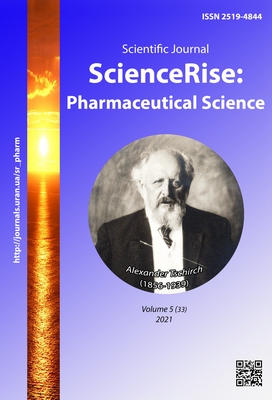Comparative pharmakognostical study of roots of Rosa Majalis Herrm. and Rosa Canina L.
DOI:
https://doi.org/10.15587/2519-4852.2021.243525Keywords:
root, Rosa, diagnostical features, morphological and anatomical structure, numerical indicatorsAbstract
The aim is to conduct a comparative pharmacognostical study of the series of roots of Rosa (R.) majalis Herrm. and Rosa (R.) canina L. with the establishment of diagnostic features of morphological and anatomical structure and boundary limits of numerical indicators of raw materials.
Materials and methods. The fresh and dry raw materials were used to study the macroscopic microscopic features by microscope Delta optical BioLight 300 (Poland). Determination of total polyphenols was performed by spectrophotometry (on a spectrophotometer Optizen POP (Korea)) and HPLC (chromatograph an Agilent 1200 3 D LC System Technologies (USA)).
Results. The morphological (nature of the surface (periderm) and fracture) and anatomical (color of cell walls and their cavities; location of the sclerenchyma; the presence of a crystalline coating of the sclerenchyma at the root of R. canina; of various elements of the remains of the tetraarchic conducting bundle in the center of the root) diagnostical features of roots of R. majalis and R. Canina were established.
Comparing the numerical values of loss on drying (not more than 10 %), total ash (not more than 5 %), extractable matter (not less than 9 %) and the quantitative content of total polyphenols (not less than 4 %) it was determined that both types of raw materials according to these indicators are almost indistinguishable.
Conclusions. Loss on drying, total ash, extractable matter and content of total polyphenols of the root of R. majalis and R. canina do not have significant differences, that is why the root of both plant species can be used as medicinal plant raw materials such as “Rose root”. The obtained data will be used in further research when creating methods of quality control of plant raw materials and phytomedicines
References
- Vasileva, O. Iu. (2006). Osobennosti ontogeneza nekotorykh vidov roda Rosa (Rosaceae). Rastitelnye resursy, 42 (3), 25–37.
- Navruzov, A. R., Shamsizade, L. A. (2011). Antotsiany plodov dvukh vidov roda Rosa. Khimiia prirodnykh soedinenii, 1, 107.
- The plant list. A working list of all plant species. Available at: http://www.theplantlist.org/tpl1.1/search?q=rosa
- Kapelian, A. I. (2015). Sezonnii ritm razvitiia introdutsirovannykh vidov roda Rosa (Rosaceae) v parke botanicheskogo sada Bin Ran (g. Sankt-Peterburg). Rastitelnye resursy, 51 (3), 357–364.
- Novruzov, A. R. (2014). Contents and dynamics of accumulation of the ascorbic acid in fruits of Rosa Canina L. Chemistry of Plant Raw Material, 3, 221–226. doi: http://doi.org/10.14258/jcprm.1403221
- Sergunova, E. V., Sorokina, A. A. (2011). Issledovaniya po standartizacii plodov shipovnika. Pharmacy, 5, 12–15.
- Crabowska, K., Janeczko, Z. (2012). Fatty acid composition of the monogalactosyldiacyl-glycerol fraction obtained from Rosa sp. And litizin. Khimiia prirodnykh soedinenii, 3, 416–418.
- Oproshanska, T., Khvorost, O. (2021). Potentiometric determination of organic acids in the medicinal plant raw material. News of Pharmacy, 1 (101), 11–17. doi: http://doi.org/10.24959/nphj.21.42
- Novruzov, A. R., SHamsizade, L. A. (2012). Karotinoidy plodov nekotorykh vidov Rosa. KHimiia prirodnykh soedinenii, 5, 802.
- Honarvar, M., Javidnia, K., Khosh-Khui, M. (2011). Essential oil composition of fresh and dried flowers of Rosa moschata from Iran. Chemistry of Natural Compounds, 47 (5), 826–828. doi: http://doi.org/10.1007/s10600-011-0075-2
- Derzhavna farmakopeia Ukrainy Dop. 1 (2.0). (2016). Kharkiv: DP «Naukovo-eksportnyi farmakopeinyi tsentr», 360.
- Kompendium. Available at: https://compendium.com.ua/
- Li, Y.-L., Dai, H.-N., Ma, G.-X., Zhang, W., Wu, T.-Y., Wang, Y.-Q. et. al. (2017). A new triterpenic acid from the roots of Rosa laevigata. Yao Xue Xue Bao, 52 (3), 425–429.
- Jiang, H., Han, H., Man, W.-J., Hou, A.-J., Guo, X.-Y., Xing, X.-D. et. al. (2020). Ursane-type triterpenoids from the roots of Rosa multiflora with their anti-inflammatory activity. Journal of Asian Natural Products Research, 22 (2), 131–137. doi: http://doi.org/10.1080/10286020.2018.1541135
- Dai, H.-N., Ma, G.-X., Zhou, J.-M., Zhong, X. Q., Zhou, Y.-L., Lv, G.-R. et. al. (2016). Triterpenoids from roots of Rosa laevigata. Zhongguo Zhong Yao Za Zhi, 41 (12), 2267–2272. doi: https://doi.org/10.4268/cjcmm20161216
- Ma, Y., Wang, Y., Zhang, H., Sun, W., Li, Z., Zhang, F. et. al. (2020). Antimicrobial mechanism of strictinin isomers extracted from the root of Rosa roxburghii Tratt (Ci Li Gen). Journal of Ethnopharmacology, 250, 112498. doi: http://doi.org/10.1016/j.jep.2019.112498
- Fan, X., Bai, L., Lin, L., Liao, D., Gong, Y., Liu, X. et. al. (2020). Studies on the chemical constituents and quality evaluation of Rosa cymosa Tratt. root. Journal of Separation Science, 43 (24), 4379–4389. doi: http://doi.org/10.1002/jssc.202000005
- Ji, Y., Xia, X., Xu, X., Zhu, N. (2019). Three new triterpenoids with their bioactives from the roots of Rosa cymosa. Natural Product Research, 34 (20), 2931–2937. doi: http://doi.org/10.1080/14786419.2019.1599886
- Huang, X.-Y., Ma, G.-X., Zhong, X.-Q., Zhou, Y.-L., Dai, H.-N., Wu, H.-F. et. al. (2014). Triterpene constituents from Rosa cymosa Tratt. Zhongguo Zhong Yao Za Zhi, 39 (23), 4637–4641.
- Park, K. H., Jeong, M. S., Park, K. J., Choi, Y. W., Seo, S. J., Lee, M. W. (2014). Topical Application of Rosa multiflora Root Extract Improves Atopic Dermatitis-Like Skin Lesions Induced by Mite Antigen in NC/Nga Mice. Biological and Pharmaceutical Bulletin, 37 (1), 178–183. doi: http://doi.org/10.1248/bpb.b13-00619
- Upton, R., Graff, A., Jolliffe, G., Länger, R., Williamson, E. (Eds.) (2011). American Herbal Pharmacopoeia: botanical pharmacognosy-microscopic characterization of botanical medicines. CRC Press, 800.
- Derzhavna farmakopeia Ukrainy (2.0). (2015). Kharkiv: DP «Naukovo-eksportnyi farmakopeinyi tsentr».
- Derzhavna farmakopeia Ukrainy Dop. 5 (2.0). (2021). Kharkiv: DP «Naukovo-eksportnyi farmakopeinyi tsentr».
- European Pharmacopoeia. Available at: https://pheur.edqm.eu/home
- Aliyev, B. M., Qabilov, M. Y., Aliyeva, I. F., Huseynova, S. A. (2019). Morphological and anatomical structure of Rosa canina L. Modern Science, 10-1, 25–28.
Downloads
Published
How to Cite
Issue
Section
License
Copyright (c) 2021 Tetiana Oproshanska, Olga Khvorost, Kateryna Skrebtsova, Konradas Vitkevicius

This work is licensed under a Creative Commons Attribution 4.0 International License.
Our journal abides by the Creative Commons CC BY copyright rights and permissions for open access journals.








